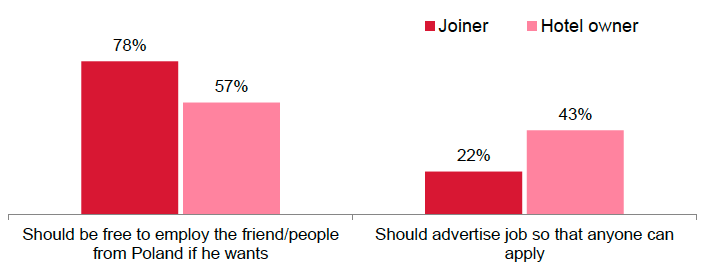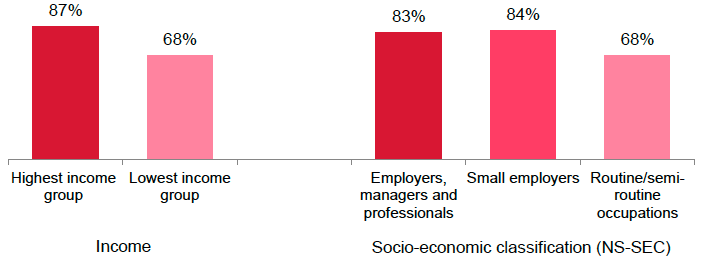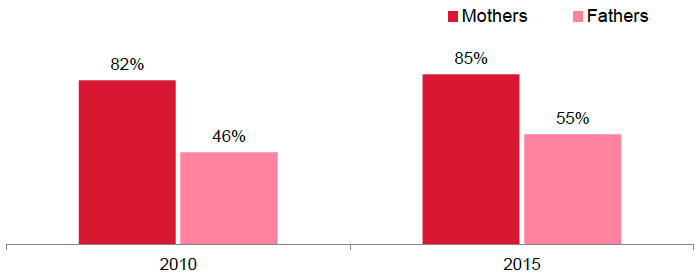Scottish Social Attitudes 2015: attitudes to discrimination and positive action
This report explores attitudes to discrimination and positive action in Scotland in relation to: age, disability, gender, race, religion, gender reassignment and sexual orientation.
This document is part of a collection
6. Employment
Introduction
This is the second of two chapters exploring discriminatory attitudes in the context of employment. Chapter 4 examined views on whether different groups of people would be suited to the job of being a primary school teacher. This chapter continues to explore discriminatory attitudes related to employment, focusing on the use of social networks for recruitment, attitudes to parental leave and whether older people should be made to retire.
Recruitment using existing social networks
SSA 2015 included two scenarios to explore attitudes in different contexts to using existing social networks for recruitment rather than advertising for a job so that anyone has the chance to apply. [21] The two scenarios were:
'A self-employed joiner employs a couple of people to help him. A vacancy has arisen for one of these jobs. The joiner meets an old friend who has worked for him before and says he would love to do the job. The joiner decides to take him on.'
'A small hotel owner who has come to Scotland from Poland needs to take on some more cleaning staff. He asks amongst his Polish friends whether they know anyone who might like the job. They tell him of two people who have also come to Scotland from Poland and who have done hotel cleaning before. He gives them both a job.'
For each scenario respondents were asked to choose one of the following two statements:
'The [joiner/hotel owner] should be free to employ [the friend/the people from Poland] if he wants.'
'The [joiner/hotel owner] should advertise the job so that anyone has a chance to apply.'
People were far less in favour of the hotel owner from Poland using his networks to employ other Polish immigrants, than they were of the joiner employing his friend. Figure 6.1 shows that over three-quarters said that the joiner should be free to employ the friend (78%) compared with just over half who said that the hotel owner should be free to employ people from Poland (57%). Conversely, twice as many people felt that the Polish hotel owner should advertise the job so that anyone could apply than felt that the joiner should advertise for the job (43% compared with 22% respectively).
Figure 6.1: Views on recruiting using existing social networks (2015, %)

Base: All respondents who completed the self-complete
Weighted base=1232, Unweighted base=1234
How do attitudes vary between groups?
The findings discussed in this section are informed by regression analysis that ascertained which factors were significantly and independently associated with believing the joiner or hotel owner 'should be free to employ the friend/people from Poland if he wants'. The following factors were explored:
- Gender
- Age
- Income
- Employment status (working, retired, unemployed etc.)
- Socio-economic class ( NS- SEC)
- General attitudes to prejudice [22]
- Whether people think that people who come here from Eastern Europe are taking jobs away from other people in Scotland
The factors associated with thinking that the joiner 'should be free to employ the friend if he wants' were gender, household income and socio-economic class. Men were more likely than women to say that the joiner 'should be free to employ the friend' (82% compared with 73% respectively) as were those in the highest income group (87%) compared with those in the lowest income group (68%). Employers, managers and professionals (83%) as well as small employers (84%) were more likely than those in routine and semi-routine occupations (68%) to think that the joiner 'should be free to employ the friend'. This suggests that those who are most likely to be involved in recruitment are more likely to support the use of existing social networks. Those who are more likely to be employees are less supportive of existing social networks being used for recruitment as they might feel that the use of social networks could exclude them from job opportunities. (See Table A6.1 in Annex A for details).
Figure 6.2 The joiner should be able to employ the friend if he wants by income and socio-economic classification (2015, %)

Base: Respondents who completed the self-complete
Weighted bases: Highest income group= 284; Lowest income group= 222; Employers= 473; Small employers=95; Routine/semi-routine occupations =345
Unweighted bases: Highest income group=254; Lowest income group= 267; Employers=466; Small employers=112; Routine/semi-routine occupations=346
In contrast, socio-economic factors were not associated with thinking that 'the hotel owner should be free to employ the people from Poland if he wants'. Only people's attitudes to whether people who come here from Eastern Europe are taking jobs away from other people in Scotland were significant. Perhaps unsurprisingly, those who agreed that 'people who come here from Eastern Europe are taking jobs away from other people in Scotland' were less likely to think that the hotel owner should be free to employ the people from Poland (39%) compared with those who disagreed that people from Eastern Europe take jobs away from people in Scotland (67%) (see Figure 6.3).
This suggests that views on the Polish hotel owner using social networks to find employees are less about people's own position in the labour market and more about attitudes to immigration and employment. To explore this further, we looked at the views of those who thought that the joiner should be free to employ who he wants but that the hotel owner should not be free to employ who he wants. Gender and views on whether Eastern Europeans take jobs away from other people in Scotland were associated with thinking that the joiner should be, and the hotel should not be, free to employ who he wants. A quarter of men compared with 19% of women held this view. Those who agreed that people from Eastern Europe are taking jobs away from other people in Scotland (34%) were more likely than those who disagreed (15%) to think that the joiner should be able to use his social networks but that the hotel owner should not. (See Table A6.2 in Annex A for details).
Figure 6.3 'Hotel owner should be free to employ the people from Poland if he wants' by whether people agree or disagree that 'people who come here from Eastern Europe are taking jobs away from other people in Scotland' (2015, %)

Base: Respondents who completed self-complete.
Weighted bases: Agree strongly/agree=370; Neither agree nor disagree=256; Disagree strongly/disagree=593
Unweighted bases: Agree strongly/agree=388; Neither agree nor disagree=264; Disagree strongly/disagree=568
Gender and employment rights
Parental leave entitlement has changed considerably in recent years. In April 2010 the Additional Paternity Leave Regulations came into force which allowed fathers or partners to take up to six months' additional parental leave if the mother or primary carer returned to work. In December 2014 the Shared Parental Leave and Pay legislation replaced the previous regulations and provides further flexibility to parents in how they choose to care for their child. Parents are able to share up to 50 weeks of leave following the birth or adoption of their child which they can take during their child's first year, either at different times or by taking the leave together.
SSA 2015 included questions to assess levels of support for two different types of parental leave. The first asked how strongly people agreed or disagreed that 'fathers or mothers should have the right to take up to 6 months paid time off work after their children are born'. [23] This question was also included in SSA 2010. In 2015 respondents were asked for the first time whether 'fathers or mothers of children under 5 should or should not be able to take up to 5 days paid leave a year to look after their child when they are ill'.
In 2015, differences in people's attitudes to maternity leave and paternity leave for six months after the birth of a child were evident. Over 8 in 10 agreed that mothers should have the right to six months paid leave (85%) compared with just over half agreeing that fathers should have the same right to six months paid leave (55%). Although attitudes to mothers having six months paid leave had not changed significantly since 2010, there had been a significant increase in support for paternity leave since 2010. In 2010, 46% agreed that fathers should have the right to six months paid leave compared with 55% in 2015 (see Figure 6.4). (See Table A6.3 in Annex A for details).
There were much higher levels of support for fathers taking up to 5 days paid leave a year to look after a sick child. Nearly 9 in 10 (89%) thought that fathers of children under 5 'definitely' or 'probably should' be able to take up to 5 days paid leave a year to look after their child when they are ill. This was similar, though slightly lower, than the equivalent figure for mothers (94%). (See Table A6.4 in Annex A for details).
Figure 6.4: 'Agree strongly' or 'agree' mothers/fathers should have the right to up to six months paid time off work after their children are born (2010, 2015, %)

Base: All respondents
How do attitudes to maternity and paternity leave vary?
This section explores whether attitudes towards up to 6 months paid parental leave varied between subgroups. Regression analysis was conducted to explore which factors were significantly and independently associated with two different points of view. These were, first, whether fathers should have the right to up to six months paid leave following the birth of a child and second, whether mothers should be entitled to up to 6 months paid leave but that fathers should not have the same rights. [24] The following factors were explored:
- Gender
- Age
- Socio-economic classification ( NS- SEC)
- Self-rated hardship
- Household type
- Education
- Income
- Current working status
- Area deprivation (as measured by the Scottish Index of Multiple Deprivation, SIMD) [25]
Younger people, aged 18-39, were more than three times as likely as those aged 65 and over (77% and 22% respectively) to say that fathers should have the right to take 6 months paid leave after their children are born. This level of support from those under 40 suggests that these changes are in tune with the attitudes of those most likely to be having children and making decisions about parental leave in the coming years (see Table A6.5 in Annex A for details). Women (58%) were more likely than men (52%) to say that fathers should be entitled to 6 months paid leave [26] and people living in the most deprived areas (66%) were more likely than those living in the least deprived areas (46%) to think that fathers should be entitled to paid leave (see Figure 6.5).
In 2010 gender and age were also significantly related to people's attitudes to parental leave. However, while self-rated hardship, socio-economic class and whether there were children in the household were related to people's attitudes in 2010, in 2015 these were not significant.
Figure 6.5: 'Agree strongly' or 'agree' fathers should have the right to 6 months paid time off work after their children are born by age and area deprivation (2015,%)

Base: All respondents
Weighted bases: 18-29=239, 30-39=227, 40-64=533, 65+=288, Most=224, Least=242.
Unweighted bases: 18-29=143, 30-39=193, 40-64=582, 65+=368, Most=178, Least=212.
Exploring which factors were associated with agreeing that mothers should have the right to take 6 months paid leave but disagreeing that fathers should have this right showed that gender, age and self-rated hardship were significant. Men (34%) were more likely than women (28%) to agree that mothers should have the right to take up to 6 months paid time off work but to disagree that fathers should, as were those aged 65 and over (50%) compared with younger people (for example, 16% of those aged 18-29) (see Figure 6.6). People who felt they were living comfortably on their current income (32%) were more likely than those who felt they were struggling on their present income (22%) to agree that mothers should, but disagree that fathers should, be able to take 6 months paid parental leave after their children are born.
Figure 6.6: 'Agree strongly' or 'agree' that mothers but not fathers should have the right to up to six months paid time off work after their children are born by gender and self-rated hardship (2015, %)

Base: All respondents.
Weighted bases: Male=617, Female=670, Comfortable=734, Struggling=172.
Unweighted bases: Male=582, Female=706, Comfortable=750, Struggling=166.
Age and employment
The age at which people should be required, or be able, to retire has continued to be an area for debate in recent years. Since 2011, employers in the UK can no longer lawfully force employees to retire simply because they reach a certain age (formerly 65). [27] However, the state retirement age ( i.e. the age at which people can draw their state pension) is continuing to rise. At present the retirement age for men is 65 and since April 2016 it has been 63 for women. [28]
In light of these continuing debates about the retirement age, SSA 2015 asked people to choose which of the following two statements is closest to their own view: [29]
'It is wrong to make people retire just because they have reached a certain age.'
'Older people should be made to retire to make way for younger age groups.'
In 2015, around 1 in 5 people (21%) felt that 'older people should be made to retire to make way for younger age groups', a proportion that has not changed since 2005. And around three-quarters said 'it is wrong to make people retire just because they have reached a certain age' (76%). [30]
So whilst in 2015 only around 2 in 10 (21%) said 'older people should be made to retire to make way for younger groups', over 3 in 10 (31%) felt that someone aged 70 would be unsuitable as a primary school teacher; [31] once again highlighting the importance of context in shaping attitudes. Around a quarter (24%) of those who said 'it is wrong to make people retire just because they have reached a certain age' still felt that someone aged 70 was unsuited to the job of being a primary school teacher. However, this has reduced since 2010, where the equivalent figure was 11 percentage points higher at 35%.
How do attitudes vary between groups?
The majority of people across all socio-economic groups said it is wrong to make people retire just because they have reached a certain age. However, among those who thought that 'older people should be made to retire to make way for younger age groups' there were significant differences by age, current working status and self-rated hardship. [32] Interestingly those who were already retired or of retirement age (65 or over) were more likely to think that people should be made to retire than people who are currently working or younger people. Figure 6.7 shows that around a third of those aged 65 and over (30%) said that people should be made to retire compared with 12% of those aged 18-29. And similarly around a third of retired people (32%) compared with 16% of those currently in work thought people should be made to retire. Those living 'really comfortably' or 'comfortably' on their present income were also more likely to think people should retire than those who are 'struggling' or 'really struggling' on their present income (21% compared with 14% respectively).
In SSA 2010, age was also significantly related to people's attitudes to making older people retire, with older people more likely than younger people to say that people should be made to retire. There were also significant differences by education in 2010; however in 2015 education was not a significant factor.
Figure 6.7: Believing that 'it is wrong to make people retire just because they have reached a certain age' by age and self-rated hardship (2015, %)

Base: All respondents
Weighted bases: Weighted bases: 18-29=238, 30-39=227, 40-64=533, 65+=288, Comfortable=734, Struggling=172.
Unweighted bases: 18-29=143, 30-39=193, 40-64=582, 65+=368, Comfortable=750, Struggling=166.
Contact
There is a problem
Thanks for your feedback